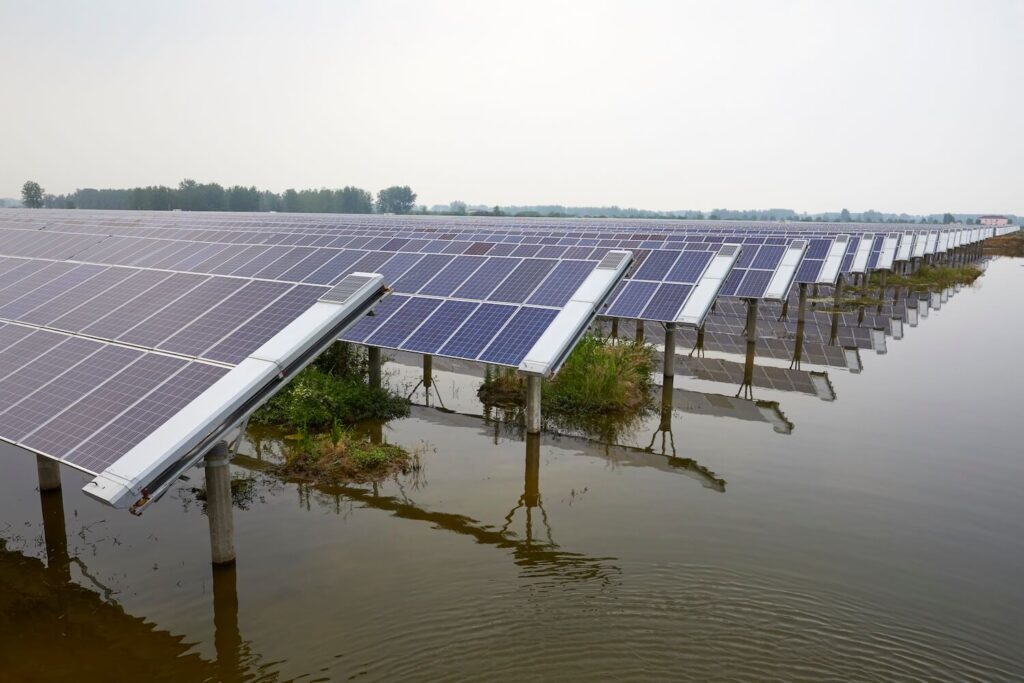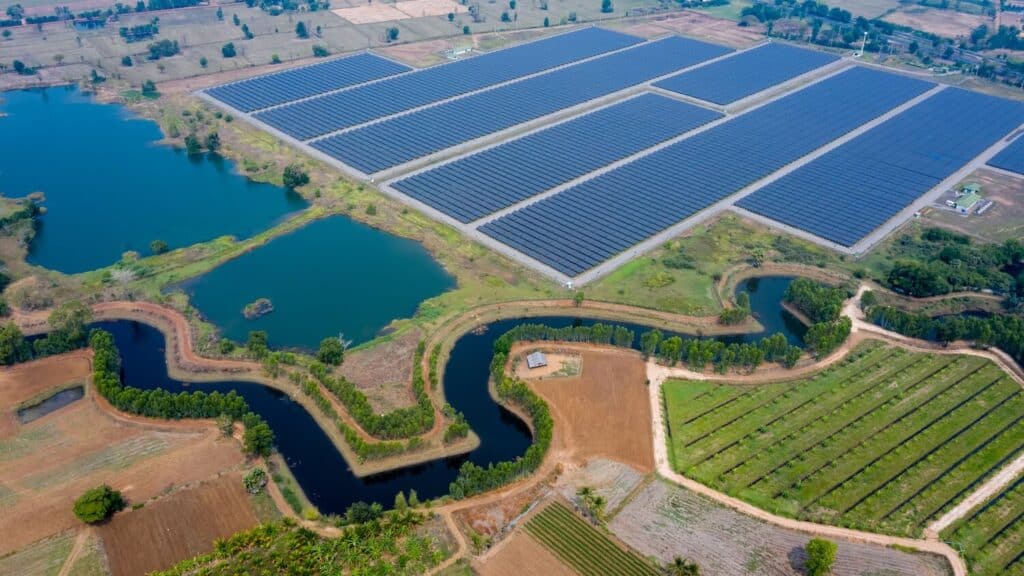POSTED
May 17, 2024
Are There Long-term Stormwater Concerns With Utility-Scale Solar?
In today’s world of investing, accredited and ESG (Environmental, Social, and Governance) investors are looking for opportunities that offer good profits while also being good for the planet. They’re increasingly interested in putting their money into things like utility-scale solar energy projects that help fight climate change. But how are solar energy projects managing stormwater? […]

In today’s world of investing, accredited and ESG (Environmental, Social, and Governance) investors are looking for opportunities that offer good profits while also being good for the planet. They’re increasingly interested in putting their money into things like utility-scale solar energy projects that help fight climate change.
But how are solar energy projects managing stormwater? We’ll explain why this matters for investors and explore how it affects the environment and the success of renewable energy projects.
Understanding Stormwater Management in Utility-scale Solar
Defining Stormwater Management in Solar Projects
Stormwater management in big solar installations means having plans and systems to handle rainwater properly. Management involves collecting, storing, treating, and controlling the flow of rainwater to prevent problems like erosion, pollution, and flooding.
Before building a solar project, it’s important to thoroughly check the site for any potential stormwater issues. Developers figure out how water moves on the land and where it might cause problems. By doing this, they can design the project in a way that reduces any negative effects on the environment.
There are different ways to manage stormwater in big solar projects. These include using systems to redirect water away from sensitive areas, like hills or streams, and building structures to hold excess water temporarily. Each solution is chosen based on the specific needs of the site and the project.
Once a solar project is built, regular upkeep is needed to make sure the stormwater systems keep working well. Maintenance includes checking for any damage, cleaning out dirt or debris, and fixing any problems that come up. By doing this, developers can make sure their project meets the rules and doesn’t harm the environment.
Environmental Impacts of Inadequate Stormwater Management
When stormwater isn’t managed properly in big solar projects, it can cause serious problems for the environment. Let’s look at some of these issues.
Stormwater runoff can carry dirt, chemicals, and other pollutants into nearby streams, lakes, and wetlands. These disruptions can harm plants and animals that rely on clean water to survive. It’s important to note that solar panels don’t release any harmful substances while they’re working.
Runoff from storms can wash away soil from the land where solar panels are installed. This erosion can make it hard for plants to grow and can even damage the surrounding ecosystem. Preventing soil erosion is crucial to keeping the land healthy and productive.
When stormwater washes away soil and disrupts the environment, it can also harm the homes of many different plants and animals. This can lead to a loss of biodiversity, meaning there are fewer different kinds of living things in the area. Effective stormwater management is key to protecting the diverse ecosystems around solar projects.

Economic Implications of Poor Stormwater Management
When stormwater isn’t managed well in big solar projects, it can also lead to financial problems. Let’s take a closer look at these issues.
If a solar project doesn’t follow the rules for managing stormwater, the people in charge might have to pay fines. These fines can add up and become very expensive. Plus, legal costs might be involved in fixing the problems to meet the regulations.
When stormwater causes problems during the construction of a solar project, it can slow things down and make the project more expensive. Fixing issues like soil erosion or polluted water might require extra time and money. Delays and budget increases caused by these issues are something investors and developers don’t want.
A solar company’s reputation is important for attracting investors and partners. If a project has problems with stormwater management, investors may be worried about investing in it. Companies that show they care about the environment and manage stormwater well are more likely to keep investors’ trust and support.

Operational Challenges and Regulatory Framework
Operational Considerations for Stormwater Management
When it comes to managing stormwater in big solar projects, there are a lot of things developers have to think about. Let’s look at some of their challenges and how they deal with them.
Each solar project is built on land with unique properties.. Things like how hilly it is, what the soil is like, what the prior site use was, and if any wetlands are nearby all affect how developers handle stormwater. They have to design systems that work with the land to keep water clean and protect nature.
Stormwater systems have to fit in with the project’s solar panels and other parts, helping save space and make everything work better. By designing things this way, developers can make sure the solar project runs smoothly while also taking care of stormwater.
Developers need to work with different groups of people like government agencies, local communities, and environmental organizations. By listening to everyone’s ideas and concerns, developers can make sure their project follows the rules and keeps everyone happy.
Regulatory Framework for Stormwater Management
There are a lot of rules about how stormwater should be managed in big solar projects. These rules come from the government, both at the national and local levels. They’re there to protect the environment and make sure projects follow the law.
The government has laws like the Clean Water Act that set the basic rules for managing stormwater. These laws aim to keep water clean and stop pollution from construction projects like building solar farms.
Each state and local area might have extra rules for managing stormwater. These rules can be different depending on the project’s location.
More and more, people are looking at new ways to manage stormwater that are better for the environment, including techniques that mimic nature and help reduce pollution and flooding. These approaches are becoming more popular as we try to protect our planet.
Community Acceptance and Environmental Stewardship
Importance of Community Engagement
It’s crucial to involve the community and talk openly about how big solar projects handle stormwater. By listening to people’s concerns and keeping them informed, developers can build trust and get support for their projects.
When planning solar projects, it’s important to think about fairness and make sure everyone is equally treated. This consideration is especially important in areas where people are already dealing with a lot of pollution and environmental problems.
Environmental Stewardship and Sustainability Practices
Managing stormwater well in big solar projects has many environmental benefits. It helps save habitats, preserves water, and even helps remove carbon from the air, making it cleaner and healthier for everyone.
Sometimes, developers work to restore and protect natural areas as part of managing stormwater. This helps keep plants and animals safe and keeps ecosystems healthy and diverse.
Managing stormwater helps with flooding and saves water. By collecting rainwater and letting it soak into the ground, we can recharge groundwater and be better prepared for droughts.
Some developments may monitor ground water quality over time, to ensure no contamination is happening as a result of a solar project.
Big solar projects produce clean energy and help fight climate change. By managing stormwater well, these projects can be even more effective in reducing carbon emissions and making communities more resilient to the effects of climate change.
Investment Implications
Before putting money into solar projects, accredited and ESG investors need to consider how the projects manage stormwater.
- Avoid risks by doing your due diligence.
Make sure the projects follow government regulations and have practical plans that can be put into action to ensure the long-term sustainability (and profitability) of your investment. - Analyze the financial risks and benefits.
It’s important to consider how stormwater affects the project’s performance, how much money the project makes, and if the project is a good investment for the long-term. - Prioritize solar projects that focus on stormwater management.
Watch out for new and creative projects and partnerships in this area, as they can offer great investment opportunities.
Conclusion
Managing stormwater well is crucial for both the environment and the money side of utility-grade solar projects. By taking proactive steps to handle stormwater, we can protect nature and make sure solar investments pay off in the long run.
If you’re thinking about investing in solar projects, it’s essential to consider how they deal with stormwater. This helps the environment and ensures your investment aligns with values like sustainability and taking care of the Earth.
For those looking to invest in renewable energy, Shasta Power’s Summit Power Fund is a great option to explore. They’re committed to managing stormwater effectively in their solar projects, positively impacting both the environment and your investment returns. Let’s work together to create a cleaner, greener future for all.





